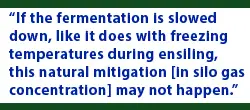
Frosty the corn silage
 By Dr. Michelle Chang-Der Bedrosian, Vita Plus forage products and dairy technical specialist, and Pat Hoffman, Vita Plus dairy technical specialist
By Dr. Michelle Chang-Der Bedrosian, Vita Plus forage products and dairy technical specialist, and Pat Hoffman, Vita Plus dairy technical specialistAutumn is here, and most of the Midwest has seen frost already. With this temperature change, producers should be thinking about how it could affect silage fermentations.
A silo mass tends to keep the temperature of the day it was ensiled. For example, under normal harvest conditions, if corn silage is harvested at an ambient temperature of 70 degrees F, the silo mass will remain 70 degrees F during storage.
 However, this year has been anything but normal, and many producers are wondering what effect ensiling during freezing temperatures will have on fermentation and the nutritive value of the corn silage.
However, this year has been anything but normal, and many producers are wondering what effect ensiling during freezing temperatures will have on fermentation and the nutritive value of the corn silage.
If you are ensiling in cooler weather, you can expect everything to slow down.
- Inoculants flow slower: When it gets colder, applicator lines may freeze up. You can add up to 10% propylene glycol to the inoculant-water mixture (about a 1-to-9-gallon ratio of propylene glycol to water) to prevent lines from freezing and to keep the inoculant flowing.
- Fermentation and pH drops are slower: Good and bad bacteria move slower in the cold. This means the pH drops slower in addition to the slow-moving inoculant. We still advise inoculating your silage because the weather will eventually warm up and the silage will ferment. The inoculant will limit both spoilage and shrink when this does happen.
- Starch digestibility doesn’t increase as quickly: The normal increase in starch digestibility (and the associated increase in soluble protein and ammonia-nitrogen) will be reduced. Monitor changes in soluble protein, ammonia, starch digestibility and fecal starch. For a limited time, you may need to run a higher amount of starch in the diet to compensate for the lower amount of available starch. You may also want to check kernel processing to ensure the starch is optimally available from the start.
- Nitrates aren’t mitigated as quickly: This can’t be said enough, if you are unsure, please test your crops for nitrates – it very well may save your life. Nitrates turn into silo gas very rapidly during the upfront fermentation. However, after a normal robust fermentation, concentration can decrease up to 50%. If the fermentation is slowed down, like it does with freezing temperatures during ensiling, this natural mitigation may not happen.
 Chopping the corn silage shorter and processing it very well may also help. This will help compensate for the lower nutrient availability because of the freezing temperatures.
Chopping the corn silage shorter and processing it very well may also help. This will help compensate for the lower nutrient availability because of the freezing temperatures.
Lastly, in theory, you would ensile the corn silage and let it ferment for an extended period. However, with forage inventories running low on many farms, some producers may have to open the silo early.
If you find yourself in this situation, stay on top of spoilage. We are getting cold spells followed by warm spells. Monitor the temperature of the silage, and perhaps add some buffered propionic acid to the TMR mixer until the ambient temperature cools down to be consistently cold.
We have seen a bunker of frozen corn “silage” feed wonderfully. We put the word silage in quotes because it never actually fermented. It remained frozen and it fed like green-chopped silage. The animals loved it. Once it started heating up during a random warm spell in March, it started spoiling very quickly and it was hard to stay ahead of the spoilage.
If you have any questions about putting up or feeding corn silage during freezing temperatures, contact your Vita Plus consultant.
| Category: |
Forage Foundations Forage harvesting Forage storage and management |

